|
VOLUNTARY SERVICE
THE RED CROSS
At the advent of First World War it was recognised that a local Red
Cross unit was necessary and William Edwin Sands (of seed potato fame)
instigated the formation of one in Culcavey and one in Lisburn. Dr
McCandless gave the lectures in Culcavey and Dr St George, followed by
Dr Page, gave the Lisburn lectures. Out of the Culcavey mens' class some
14 men went on to serve in military hospitals at home and abroad. Tommy
Wright was one such member that can be named who served in hospitals.
Two brothers, Oliver and
Harry Adams, were also members.
V.A.D.
 It was not only the men of the area who provided their services to the
Nation, women all over the country were determined to do their bit. War
brings casualties and this is where the women came into their own. The
V.A.D. (Voluntary Aid Detachment) formed in Culcavey was led by Miss
Elizabeth Hogan, daughter of Rev. Hogan. When Miss Hogan left to live in
England, Mrs Pimm took over her post. Miss Phenix Maze also joined and
then went on to nurse in Scotland. A letter from Miss Hogan to Margaret
Hall Sands dated September 1915 asked if any more members had
volunteered for military nursing as her sister Annie had been accepted
and had been sent to Egypt to help nurse the soldiers who had been
fighting so nobly in the Dardanelles. Mrs McCarthy, mother of Tommy
McCarthy who is mentioned in this book, was also a prominent member. It was not only the men of the area who provided their services to the
Nation, women all over the country were determined to do their bit. War
brings casualties and this is where the women came into their own. The
V.A.D. (Voluntary Aid Detachment) formed in Culcavey was led by Miss
Elizabeth Hogan, daughter of Rev. Hogan. When Miss Hogan left to live in
England, Mrs Pimm took over her post. Miss Phenix Maze also joined and
then went on to nurse in Scotland. A letter from Miss Hogan to Margaret
Hall Sands dated September 1915 asked if any more members had
volunteered for military nursing as her sister Annie had been accepted
and had been sent to Egypt to help nurse the soldiers who had been
fighting so nobly in the Dardanelles. Mrs McCarthy, mother of Tommy
McCarthy who is mentioned in this book, was also a prominent member.
THE SECOND WORLD WAR
The pain of the First World War was repeated again for the people of the
area with the advent of Second World War when in the area from Newport
Bridge to the Factory all the following men enlisted: Tommy McMullen,
killed in N. Africa; Bertie Singleton, captured at Arnhem; Tom
Armstrong; Alfie Steel; Tommy Pollock; Walter Berry; Bob Kane; Eddie
Kane; Tommy Kane; Jack Lynas; George Smith; Billy Boal; Albert Pollock;
Tom Dickinson; Davy McCabe; William Cargin (died on active service);
Peeler' (Jim) McAdam; Alfie Wilcox; Tom Wilcox; William Cairns; Bob
Cairns. From other parts of the area came Tom Martin, William Martin,
Dougie Armstrong, Lily Armstrong, Robert Cumins, Willie John Singleton,
Albert Crothers, George Hanna and Wilson White, Jnr. Although not from the area, other
soldiers and airmen married local girls: Al Sulsh, RAF (killed on active
service); Bertie Campbell (prisoner of war); Harry Riddle; Jim Jackson;
Bill Prince; Eddie Prior. These men saw and were involved in some of the
worst fighting of the war. Prince and Jackson were wounded.
The above does not represent a totally comprehensive list of names,
there may be others who enlisted and did their duty.
Death came irrespective of age or circumstance, as in
the case of
LEADING AIRCRAFTMAN OLIVER CUMINS
On 31st May 1941, Oliver Cumins of Carnbane House lost his life in
an aeroplane crash just over two miles away from the RAF base at Pwlleli,
north Wales.
At the time a local newspaper gave this account of the
tragedy:
"Intimation has been received by Mr and Mrs JM Cumins,
of Carnbane House, Lisburn, that their second son Leading Aircraftman
Oliver Cumins, has been killed. Leading Aircraftman Cumins, who joined
the RAF in January was training as an observer. He was an official of
the Ulster Bank Ltd., and had been a member of the head office and
Enniskillen Branch staffs. He was educated at the Royal Belfast
Academical Institution."
The Commonwealth War Graves Commission Debt of Honour
Register records the deaths of the following local men:

PRIVATE WILLIAM CARGIN
William Cargin served in the Aux. Mil. Pioneer Corps and died on 26th
September 1940. He is buried in Maze Presbyterian Churchyard.
CORPORAL GEORGE GILMORE
George Gilmore, who lived at Bog Road, died on 21st February 1945 at the
age of 29. He served in the 3rd Btn., Irish Guards, and was husband of
Georgina Gilmore of Ballynahinch. George was buried at Milsbeek War
Cemetery, Limburg, Netherlands, the resting place of men from the 51st
(Highland) Division, the 52nd (Lowland) Division, and the 3rd Battalion
Irish Guards.
CORPORAL JAMES HENRY GILMORE
James Henry Gilmore, son of Isaiah and Emma Gilmore of
Lisburn and brother of the above, served with the 4th Parachute Btn.,
Army Air Corps, and died on 31st May 1944 at the age of 22. He is buried
at Salerno War Cemetery, Italy.
ENGINE ROOM ARTIFICER 4TH CLASS JOHN McKEE
John McKee served on H.M.S. Kongoni, Royal Navy and lost his life on 9th
November 1942 aged 27, and was interred at Johannesburg (West Park)
Cemetery, Gauteng, South Africa. He was son of George and Rhoda McKee of
Belfast. George lived at No.1 English Row.
LANCE CORPORAL THOMAS McMULLEN
Thomas McMullen served with the 6th Btn., Royal Inniskilling Fusiliers
and lost his life on 27th April 1943. He was laid to rest in
Medjez-El-Bab War Cemetery, Tunisia. Thomas was the son of Robert James
McMullan & Isabella McMullan, and nephew of John Cairns, Newport,
Hillsborough.
You just have to visit the cemetery of our All
Saints' Eglantine Church to recognise the price paid not only by our
native boys, but also those outside this island. The row of war graves
makes poignant reading, a memorial to those who lost their lives so far
from home and rest in the peace of Eglantine.

| A.C.I. |
ASHARD, Reginald
Edward, R.A.F. V.R., 19th July 1945 |
| Flying Officer |
ASPINALL, Maurice John
William, R.C.A.F. 23rd July 1943. Aged 22. Son of Maurice and
Isobel Aspinall; husband of Joan Frances Aspinall, of Stratford,
Ontario, Canada. |
| Air Gnr. |
ASTON, Oliver, R.A.F.
V.R., 19TH March 1945. Age 19. Son of Harry and Dorothy Aston of
West Derby, Liverpool |
| Sergeant |
BRAMWELL, Jack, R.A.F.
V.R., 14th March 1944. Age 21. Son of George and Clara Bramwell
of Stockport, Cheshire; husband of Marjorie Warrington Bramwell
of Stockport. |
| Flight Sergeant |
CHABARA, Alexander
James, R.C.A.F., 16th September 1943. Age 25. Son of Nick and
Rose Chabara of Vilna, Alberta, Canada. |
| Flying Officer |
CONNELL, Francis
Aloysius, R.A.A.F., 29th November 1943. Age 22. Son of Charles
and Margaret Connell of Parramatta, New South Wales, Australia. |
| Sergeant |
EAGLEN, Reginald
Douglas, R.A.F. V.R., 23rd July 1943. Age 21. Son of Thomas
Henry and Carrie Isabele Eaglen of York. |
| Air Gnr. |
EDGE, Ronald James,
R.A.F. V.R., 19th March 1945. Age 23. Son of William Foster Edge
and Marthe Edge of Higham's Park, Essex. |
| Wt. Officer |
FENN, Bertie, R.A.F.,
27th May 1946. Age 49. Son of Edwin and Mary Ann Fenn; husband
of Frances Maud Fenn of Bigbury, Devon. |
| Flying Officer (Pilot) |
GALVIN, Alwyne James,
R.N.Z.A., 14th March 1944. Age 23. Son of John and Kathleen
Galvin of Turua, Auckland, New Zealand. |
| FIt. Sergeant(W.Op./Air Gnr.) |
GIBBISON, Andrew
Greenwell, R..N.Z.A., 18th November 1943. Age 22. Son of Francis
B.M. Gibbison and of Coralie Gibbison (nee Carr) of Kaurea,
Auckland, New Zealand. |
| Flying Officer (Pilot) |
HOLMES, William Ivan,
R.N.Z.A.F., 19th March 1943. Age 23. Son of William John and
Margaret Ellen Holmes of Pukekohe East, Auckland, New Zealand;
husband of Marion E. Holmes of Pukekohe East. |
| Sergeant (Flt. Engr.) |
HOOK, Rolinson Sidney
Palliser, R.A.F. V.R., 19TH March 1945. Age 22. Son of Sidney
Richard George and Anni Hook of Totton, Hampshire. |
| Flying Officer |
KEANE, John Russell,
R.A.A.F., 29th November 1943. Age 26. Son of Gerald Thomas Keane
and Freda Grace Keane of East Brunswick, Victoria, Australia. |
| Flight Sergeant |
McCALLUM, Norman
Francis Dougald, R.A.A.F., 29TH November 1943. Age 23. Son of
Richard and Mary Isabella McCallum of Wallacedale, Victoria,
Australia. |
| Flight Sergeant |
MULLINS, William
Murray, R.A.A.F., 29th November 1943. Age 29. Son of Patrick
Murray Mullins and Julia Ethel Mullins of Footscray, Victoria,
Australia. |
| Flight Sergeant |
POTTER, Alan Gilbert,
R.A.A.F., 23RD July 1943. Age 30. Son of Joseph and Marion Ruth
Potter; husband of Eunice Laurel Potter of Prospect, South
Australia. |
| Flying Officer |
PRYDE, Alan James,
R.A.A.F., 19th March 1945. Age 23. Son of Harry Ewart Gladstone
Pryde and Margaret Mary Pryde of Oatlands, Tasmania, Australia. |
| Pilot Officer (Flt.Eng.) |
SULSH, Samuel Alfred,
R.A.F. V.R., 20th April 1945. Age 39. Husband of Aileen Norah
Sulsh of Hillsborough. |
| Flight Sergeant |
TAUBMAN, Kenneth John,
R.A.A.F., 8th August 1944. Age 22. Son of Claude Percival and
ary Taubman; husband of Patricia Finlay Taubman of Marrickwille,
New South Wales, Australia. |
| Flying Officer (Pilot) |
VANCE, Gordon Elgin,
R.C.A.F., R.A.F., Sqdn., 15th April 1944. Age 22. Son of Samuel
and Beatrice Emily Vance of Willipege, Manitoba, Canada. |

On 8th September 1990 a memorial window at the back
of Eglantine church was dedicated to all the 21 airmen buried in the
graveyard. The last aircraft incident involving major loss of life
during the Second world War was on 19th March 1945 when the crew of a
Liberator aeroplane, based at RAF Aldergrove, crashed on Colin Mountain,
killing eleven airmen. Five of the crew now rest peacefully in
Eglantine. A memorial service was held in the Church on 19th March 1995
to mark the 50th anniversary of the crash.
The crew of Liberator KG 896
(1674 HCU � Aldergrove)
Crashed 19th March 1945
| Flying Officer |
William Ian Holmes,
R.N.Z.A.F. (Pilot) |
| Pilot Officer |
Alan James Pryde,
R.A.A.F. (Pilot) |
| Sergeant |
Oliver Aston, R.A.F.
V.R. (Air Gunner) |
| Sergeant |
Ronald James Edge,
R.A.F. V.R. (Air Gunner) |
| Sergeant |
Robinson Sidney
Palliser Hook, R.A.F. V.R. (Flt. Engineer) |
|
also |
| Flying Officer |
William Davis
Cheyne, R.A.F. V.R. (Wireless Operator) |
| Flying Officer |
Cecil Andrew James
Honey, R.C.A.F. (Navigator) |
| Pilot Officer |
Richard Henry
Appleyard, R.C.A.F. (Navigator) |
| Pilot Officer |
Stanley Frederick
Bright Sargent, R.A.F. (Navigator) |
| Sergeant |
Dennis Archibald
Bates, R.A.F. (Wop/Air Gunner) |
| Sergeant |
Patrick McNeilly,
R.A.F. V.R. (Wireless Operator) |

REMEMBRANCE
By Bertie Emerson
At the foot of the hill
In the heart of our town
Friends and neighbours erected a cross
The first war had ended
And its long toll of dead
Showed our district had suffered great loss.
`King and country need you'
Was the clarion call
Which drew thousands our realm to defend
The cross bears the names
Of those gallant young men
Whose lives were so quickly to end.
Twenty one years have passed
Will mankind ever learn!
Fire bombs raining down from the skies
Our cities in flames
Instant death grief and pain
With resistance, our nations survive.
As a mark of respect
To the cross they go back
V Day, found them all overjoyed
More names were enscribed
Of the loved ones who fell
Far away in locations world wide.
At the foot of the hill
In the heart of our town
Old men sit watching children at play
We must never forget
That those dead gave their lives
So that we can have freedom today.

 CORPORAL EDWARD KANE CORPORAL EDWARD KANE
On 4 December 1943 a reception was held in Newport School to mark
the return to Culcavey of Edward Kane, who had distinguished himself in
the North African campaigns of the Second World War. The many places he
had fought (Adina, Kassala, Massara, Eritrea, El Alemain, Tobruk,
Benghazi, Tripoli, Tunis) were, no doubt, simply names on the globe in
that schoolroom to most of those present.
By 1943 Edward Kane had served in the army for seven
years. On the night of reception back to Culcavey, a poem, composed
specially for the occasion by RJ Emerson, was read. This poem runs to
twenty verses and extols the virtues of this son of Culcavey, but the
last seven are particularly poignant and deserve to be quoted:
 Yes, Coporal Kane, a native Culcavey bred and born Yes, Coporal Kane, a native Culcavey bred and born
Some eight and twenty years ago
One nice midsummer's morn
And, now he's grown to manhood
Has brought the place renown -
A gallant son of Ulster
And dear old County Down
Yes, we are proud of Ulster
And proud of County Down
And prouder of Culcavey
Where such heroes can be found
Forgetting not Montgomery
Alexander, Brooke and Dill -
A quartet of Ulster generals
That gave us all a thrill
Their deeds of daring leadership
Admired by all the world
Have restored respect and homage
Where the Union Jack's unfurled
That emblem of freedom
Will flutter in the breeze
And the white ensign of empire
Will sail the seven seas
When the battle strife is over
And peace has come again
Our cause will be victorious
Thanks to men like Corporal Kane!

SERGEANT BERTIE CAMPBELL
 Many local girls married ex-servicemen, some of whom had been stationed
at Hillsborough Castle. Agnes Kane of Hillside Terrace had married
Sergeant Bertie Campbell of the Inniskilling Fusiliers. His tale
reflects the horrors of war, as he received a posting to France in 1939
and spent much of the war in a prisoner-of-war camp. Many local girls married ex-servicemen, some of whom had been stationed
at Hillsborough Castle. Agnes Kane of Hillside Terrace had married
Sergeant Bertie Campbell of the Inniskilling Fusiliers. His tale
reflects the horrors of war, as he received a posting to France in 1939
and spent much of the war in a prisoner-of-war camp.
In 1987, a lifetime after the events of the war,
Bertie's family received a letter from the British Legion along with a
note and a photograph of Bertie and another prisoner-of �war at a
graveside. The photograph shows Bertie standing beside Corporal Jimmy
Creggan at the grave of Ronald Story. The British Legion had wanted to
discover more about Story and had contacted Bertie Campbell. What was
revealed at the time was the bravery and determination of the British
soldiers, for the photograph had to be carried during a forced march to
be smuggled from the camp. The back of it bears rubber stamp mark � 'Stalag
XX A Geuprit 21'. This was a prison camp near the border of Poland.
Bertie Campbell was always reluctant to talk about
his wartime experiences, but when asked how the Germans treated him, he
would say, "The officers received worse treatment than us".
BERTIE SINGLETON
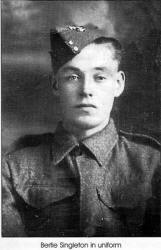 Bertie was born in the Halftown on 8th September 1922 to Elizabeth Anne
and Albert Singleton. He was fourth in a family of six: Kathleen,
Victoria, Nancy, Albert, John and Mary. He attended Newport Public
Elementary School under the guidance of Miss Baird, Miss Blanche Beattie
and Headmaster Mr JJV Boyd. Bertie helped at Leathem's farm on the
Blaris Road after school hours and during holidays, and was employed
here when he left school. Mr Boyd helped get him a job in JC Patterson's
Hardware and Furniture shop, but Bertie preferred the open air and
returned to Leathem's after about a week. Bertie was born in the Halftown on 8th September 1922 to Elizabeth Anne
and Albert Singleton. He was fourth in a family of six: Kathleen,
Victoria, Nancy, Albert, John and Mary. He attended Newport Public
Elementary School under the guidance of Miss Baird, Miss Blanche Beattie
and Headmaster Mr JJV Boyd. Bertie helped at Leathem's farm on the
Blaris Road after school hours and during holidays, and was employed
here when he left school. Mr Boyd helped get him a job in JC Patterson's
Hardware and Furniture shop, but Bertie preferred the open air and
returned to Leathem's after about a week.
When the Second World War broke out Bertie, at the
age of 18, joined The Royal Inniskilling Fusiliers, Regtl. No.6984172.
Around about the same time his mates, Tommy Martin and Tom Armstrong,
also joined. Bertie applied to join the Parachute Regiment and spent some time in the Royal Irish Fusiliers and the
Royal Ulster Rifles, training and waiting for the full transfer. He
spent the rest of his time in the 3rd Battalion Parachute Regiment and
served with the 1st Army in Algiers and Morocco. At the attack on Sicily
the tail of his `plane was hit and caught fire, but the pilot would not
allow them to jump. This may well have saved his life because about half
the troops who dropped fell to their death because there was not enough
time for the parachutes to open. The recommended height to drop was 900
ft. and they went in about 600 ft. to avoid flak. Bertie returned to
Sicily and went on to fight in the Italian Campaign.
After returning to the UK in 1943 he went into
training for the Invasion of Europe. However, he saw no further action
until the drop of the 1st Airborne Division at Arnhem on 17th September
1944. Fortunately or unfortunately he was taken prisoner next day. The
information given about the number and status of German troops was very
widely inaccurate and the whole area was covered with them. Many of them
had been pulled back from the front to rest and regroup.
Bertie seldom had a hard word for anyone (perhaps
because of his Mother's teaching, that if you couldn't say a good word
about anyone you don't say anything about them) and had nothing bad to
say about how he was treated as a prisoner. He was only 5 stone when he
was repatriated but praised the German Sgt. Major in charge of his work
party for turning his back while they munched a raw turnip, even
intimating that they should eat it all in case the remains were
discovered. Anyone caught stealing food had their head put down the
toilet, and they were not flush toilets! He said the Germans were no
better off than they were. Bertie's brother John could have got leave to
go home to see him, but was advised by his Company Commander to wait a
couple of weeks to allow him to recuperate, because he wouldn't like
what he saw. He comments "In that fortnight Bertie had got up to
8 stone. I was glad I waited".
When Bertie returned home the people of Newport and
district had a great night to celebrate his arrival, where the local
talent excelled itself in song and poetry etc. He received a wallet with
money collected for the occasion and also a watch suitably inscribed on
the back and which still goes.
When he returned to the Army Bertie had to do
parachute jumps to continue his entitlement to Paratroops pay. During
one such operation he fell into a barbed-wire entanglement where he cut
his shin. The wound didn't heal readily and he spent some time in
hospital in Chichester. John, recently stationed at Singleton Camp near
Chichester, went to see him but found Bertie had shifted away just the
day before. Bertie left the army shortly after that and returned to live
with his mother at Newport.
For those who had the privilege to know the quiet and
unassuming man that Bertie was is aptly weighed up by his brother "While
the rest of us went off and got married Bertie stayed single, we all
believed to look after our Mother. He usually did put others before
himself'.
(The above information is supplied from the loving
memories of his brother John.)
THE ATC (AIR TRAINING CORPS)
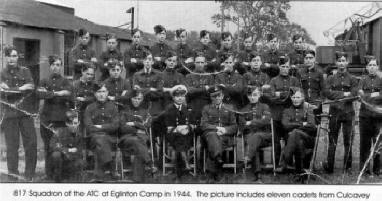 Whilst the Second World War was progressing the next generation were
preparing themselves for service. A squadron of the Air Training Corps
was formed in Lisburn Technical School in 1941. In 1942 Mr. WA Kirkwood,
Principal of Downshire School, Hillsborough, formed a new wing of 817
Squadron. Many of the boys from Culcavey joined and were trained to a
very high standard, ready to transfer to the RAF if needed. However, the
age groups of most of the boys meant they were too young when the war
ended. Some of them did enter the RAF. Corporal Thompson Crossey of the
Hillsborough Wing represented Northern Ireland ATC as a member of the
football team and as a lightweight boxer against England, Scotland and
Wales. The Hillsborough Wing was disbanded in the 1950s. Whilst the Second World War was progressing the next generation were
preparing themselves for service. A squadron of the Air Training Corps
was formed in Lisburn Technical School in 1941. In 1942 Mr. WA Kirkwood,
Principal of Downshire School, Hillsborough, formed a new wing of 817
Squadron. Many of the boys from Culcavey joined and were trained to a
very high standard, ready to transfer to the RAF if needed. However, the
age groups of most of the boys meant they were too young when the war
ended. Some of them did enter the RAF. Corporal Thompson Crossey of the
Hillsborough Wing represented Northern Ireland ATC as a member of the
football team and as a lightweight boxer against England, Scotland and
Wales. The Hillsborough Wing was disbanded in the 1950s.

OUR PEOPLE
It is worth recording some of the people that set out
and made a name for themselves in the world outside the small area of
Culcavey and Halftown. The younger generation may be unaware that these
people had their achievements and careers well documented and were
remarkable in their time. So too should be recognised those within the
community who contributed so much to it.
REX AND CROMIE McCANDLESS
Many people with an interest in engineering, motorcycles or even
aviation will have heard of Rex and Cromie McCandless, natives of
Culcavey who lived at Laurelvale House, Puddledock Road.
Rex was born in 1915 and his brother, Cromie, nine
years later. The family had long been engaged in farming, but Rex's
career in particular was to take him in a very different direction. He
admitted that he was no great academic at school, but acknowledged that
his aunt's gift to him of a 1923 side valve Raleigh motorcycle was a
real turning point which began his passion for all things mechanical.
After a spell with the NAAFI at RAF Uxbridge, Rex worked servicing
lorries for the Daily Herald newspaper. Before the outbreak of the
Second World War he returned to Northern Ireland to work for
Short and Harland. The wages from this job were used to fuel Rex's love
of motorbikes, and in 1940 he entered the Irish 500 road race
championship with his Triumph Tiger 100. He took the lap record at 79.75
mph. Despite highly placed finishes, Rex always saw himself as the
engineer, while Cromie was the racer. Indeed, significant among Cromie's
wins was his dramatic success in the 1952 Senior Ulster Grand Prix.
In 1943 the brothers set up in business on Belfast's
Dublin Road, taking on any kind of engineering work. The standard of
workmanship was so high that the Northern Ireland Ministry of
Agriculture awarded them several contracts. Success bred success and
expansion followed with a partnership with Artie Bell, resulting in the
foundation of Bell and McCandless.
While committed to his business, Rex toyed with ideas
of improving motorcycle performance and handling. Rex's labours resulted
in the construction of the `Benial' frame for motorbikes. This in turn
gave the basis for the Norton Featherbed, which along with Rex's
development of the rear suspension system, revolutionised motorcycling.
This was proved as early as 1946 at Brands Hatch. Rex established a
seven-year association with the Norton Company which allowed them to
stay ahead of the stiff Italian competition in road racing. By 1950 Rex
McCandless became interested in methods of improving four-wheel drive
vehicles, and his ideas attracted the attention of the famous Harry
Ferguson. So impressed was Ferguson that he funded the work. After
extensive work, the four-wheel drive Mule was engineered and was so
effective that the British army expressed interest in using it. Rex was
offered, and refused, the technical directorship of Harry Ferguson
Limited. In the event, Ferguson did not utilise the Mule, thus
presenting a lost opportunity.
Rex McCandless also built racing cars, with the chassisless McCandless Trials Car coming third in the 1956 Boxing Day
trial. With experimentation in the making of bricks, Rex believed in
diversification � even to the extent of going into aviation. In 1959 Rex
and Cromie bought a De Havilland Hornet Moth aeroplane. Again, Rex's
expert eye could visualise how this could be made more effective and so
he built the McCandless Autogyro. It was an indication of his
level-headedness that he always tested his machines himself.
The work of Rex McCandless, always supported by
Cromie, is recollected at the Ulster Folk and Transport Museum, where
important examples of his work can now be seen. Rex's ability to
overcome mechanical hindrances is summed up by a phrase he often used:
"When you solve a problem, you haven't got one".

ELSIE KELSEY
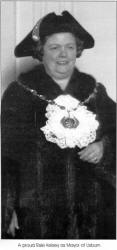 Elsie Kelsey (nee McBride) was born and brought up at Demiville House,
Halftown. Within the community she is remembered with fondness and
pride. Her contribution to and interest in the life of the area was of
the highest order. Taking a keen interest in politics she was a staunch
Unionist and her efforts and input were finally recognised when she was
made Mayor of Lisburn. In this role she was able to display the wealth
of experience in public life and the commitment and dedication that was
her hallmark. Elsie was committed to her Church and God, and as a
lifetime member of All Saints' Eglantine Church she participated in
every aspect of Church life. The people of the area were proud of her
achievements, this girl from the Halftown - one of our own'! Elsie Kelsey (nee McBride) was born and brought up at Demiville House,
Halftown. Within the community she is remembered with fondness and
pride. Her contribution to and interest in the life of the area was of
the highest order. Taking a keen interest in politics she was a staunch
Unionist and her efforts and input were finally recognised when she was
made Mayor of Lisburn. In this role she was able to display the wealth
of experience in public life and the commitment and dedication that was
her hallmark. Elsie was committed to her Church and God, and as a
lifetime member of All Saints' Eglantine Church she participated in
every aspect of Church life. The people of the area were proud of her
achievements, this girl from the Halftown - one of our own'!
BRIAN NELSON
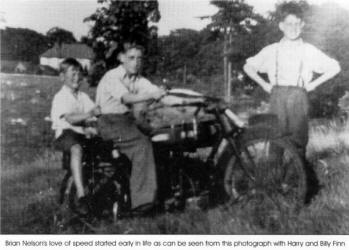 Here is one man who can trace his family roots in the area right back to
the 1750s. That alone is remarkable, but Brian Nelson's contribution to
the world of racing makes a story in itself. He probably inherited his
mechanical inclination from his father, Hubert, but in his own words he
was "always at speed, should it have been pushing the pram or a bicycle,
but it eventually ended up with motorbikes and then racing cars". Brian
won the Irish and Scottish Formula Libre Championships as well as
establishing the first 100 mph laps of Kirkistown and Bishopscourt,
creating the Craigantlet Hill record on three annual occasions and
winning his championship race at Sebring, Florida, USA. Here is one man who can trace his family roots in the area right back to
the 1750s. That alone is remarkable, but Brian Nelson's contribution to
the world of racing makes a story in itself. He probably inherited his
mechanical inclination from his father, Hubert, but in his own words he
was "always at speed, should it have been pushing the pram or a bicycle,
but it eventually ended up with motorbikes and then racing cars". Brian
won the Irish and Scottish Formula Libre Championships as well as
establishing the first 100 mph laps of Kirkistown and Bishopscourt,
creating the Craigantlet Hill record on three annual occasions and
winning his championship race at Sebring, Florida, USA.
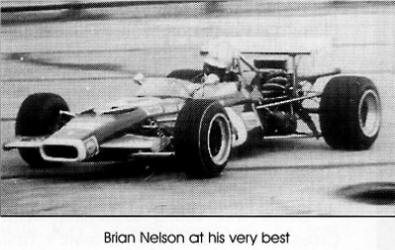 Brian was much associated with Crossle cars. The 16F,
Crossle's first and highly successful Formula Ford, which started its
production run in 1969, was campaigned by Brian in 1970 in the early
European races. A one-off Formula 3 car built late 1969 for the 1970
season using a 1000cc Ford Cosworth engine was raced by Brian. A 1970
Formula 2 car, using 1600 Cosworth F.V.A. engine and Hewland FT gearbox
was raced very successfully by him in Ireland and Scotland, and in three
rounds of the European Formula 2 Championship, and in which he broke the
hill record at Craigantlet. Brian was much associated with Crossle cars. The 16F,
Crossle's first and highly successful Formula Ford, which started its
production run in 1969, was campaigned by Brian in 1970 in the early
European races. A one-off Formula 3 car built late 1969 for the 1970
season using a 1000cc Ford Cosworth engine was raced by Brian. A 1970
Formula 2 car, using 1600 Cosworth F.V.A. engine and Hewland FT gearbox
was raced very successfully by him in Ireland and Scotland, and in three
rounds of the European Formula 2 Championship, and in which he broke the
hill record at Craigantlet.
As a change from the fast racing circuit, Brian
changed direction to do something different, and of course it had to be
cars. He changed to Rally Cars and won the Irish Tarmac Championship
before, as he says, "I decided it was time to get married"!
TOMMY McCARTHY
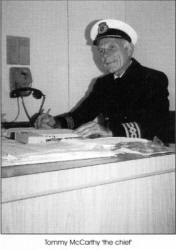 Tommy was born at the lower Maze, lived at Newport, Eglantine Road and
Thompson's Row, Culcavey. He attended Newport Public Elementary School
and Lisburn Central Primary, with further education at Lisburn Technical
College 1939-42. Tommy was born at the lower Maze, lived at Newport, Eglantine Road and
Thompson's Row, Culcavey. He attended Newport Public Elementary School
and Lisburn Central Primary, with further education at Lisburn Technical
College 1939-42.
Whilst serving an Engineering Apprenticeship in
Belfast from 1942-48 he gained experience in Workshops and Drawing
Office, plus the Jig Tool Drawing Office. Despite the hard work he
attended Lisburn Tech. evening classes and Belfast College of
Technology, and obtained his National Certificate in Mechanical
Engineering. From 1948-51 he was Assistant to the Works Production
Engineer.
Embarking into a wider world Tommy joined the
Merchant Navy in 951, and his first voyage was with P.S.N.C. to the west
coast of South America (Columbia, Peru, Chile, etc.). From late in 1951
until 1959 he joined the Elder Dempster Lines, serving on various ships,
including R.M.V. "Aureol", sailing mainly to West Africa, South Africa,
Canada and the USA. Still studying, he obtained his 2nd Engineers
Certificate (Diesel) in 1954 and his Chief Engineers Certificate
(Diesel) in 1958.
From 1959-61 Tommy was with the Cunard White Star
Line, sailing on R.M.S. "Queen Mary" and "Britannic" to the USA. In 1961
he added to his qualifications with the Combined Chief Engineers
Certificate (Steam & Diesel).
British Rail Sealink Ferries, Larne-Stranraer Service
gained his services in 1961, where as Chief Engineer Officer he stayed
until his early retirement in 1989. During his time with them he served
on S.S. "Princess Margaret", S.S. "Caledonian Princess", M.V. "Antrim
Princess", M.V. "Ailsa Princess", M.V. "Galloway Princess".
Many local people who travelled on these vessels
would have been surprised that the `Chief' was a wee boy from Culcavey!

HARRY FINN
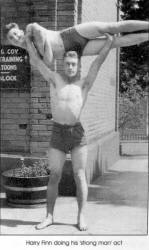 Even after World War Two many of the local lads still considered a
career in the Services. Harry Finn, who lived at Harry's Road and then
Newport, left the area in 1952 to work as a steel-erector in the
construction industry in North-east England. In 1954 he joined the
Parachute Regiment, and after selection and training was posted to 1
Para. He saw active service in Malaya during the communist incursions,
spending six years in the jungles of Malaya, Borneo and in the deserts
and mountains of the Persian Gulf area. In 1961 he was detached to serve
with the Sultan of Muscat's Armed Forces patrolling with a Bedouin unit
against the communist dissidents. 1963 saw him joining 1 East Anglian
(now Royal Anglian) for active service in the Radfan and Aden
campaigns, later serving in Germany and his homeland. On promotion to
Warrant Officer Class I (RSM) in 1972 he took up appointment of Garrison
Sergeant Major of Gibraltar. 1972 saw a return to England where he
carried out the duties of Inspector of T.A. Centres and Recruiting
Offices in the East of England. After a 22 year career in the army he
joined a large public school to train the Cadet Force and run
adventurous training trips, mainly in the mountains. In 1986 he started
his own business in Norfolk. Even after World War Two many of the local lads still considered a
career in the Services. Harry Finn, who lived at Harry's Road and then
Newport, left the area in 1952 to work as a steel-erector in the
construction industry in North-east England. In 1954 he joined the
Parachute Regiment, and after selection and training was posted to 1
Para. He saw active service in Malaya during the communist incursions,
spending six years in the jungles of Malaya, Borneo and in the deserts
and mountains of the Persian Gulf area. In 1961 he was detached to serve
with the Sultan of Muscat's Armed Forces patrolling with a Bedouin unit
against the communist dissidents. 1963 saw him joining 1 East Anglian
(now Royal Anglian) for active service in the Radfan and Aden
campaigns, later serving in Germany and his homeland. On promotion to
Warrant Officer Class I (RSM) in 1972 he took up appointment of Garrison
Sergeant Major of Gibraltar. 1972 saw a return to England where he
carried out the duties of Inspector of T.A. Centres and Recruiting
Offices in the East of England. After a 22 year career in the army he
joined a large public school to train the Cadet Force and run
adventurous training trips, mainly in the mountains. In 1986 he started
his own business in Norfolk.
In Harry's varied career he met and rubbed shoulder
with many well-known people, as his large montage of photographs would
show. However, he is well remembered in Culcavey for his strong man act
at `the corner' of lifting his friends and holding them above his head!
JOHNNY PALMER
 Everyone in the area knew Johnny Palmer, travelling round in his van
bringing groceries etc. to the people of the area. Born of a farming
family in the Halftown Johnny knew the area and its people well. in
September 1962 the Ulster Star did an article on Johnny starting with
the quotation "Palmer in the middle ages was an itinerant monk - one who
wandered from place to place. This is a story of a modern day Palmer. A
man who moved from place to place - but not of his own choosing". It
outlined a story of Johnny and his family from 1941 to 1962. Everyone in the area knew Johnny Palmer, travelling round in his van
bringing groceries etc. to the people of the area. Born of a farming
family in the Halftown Johnny knew the area and its people well. in
September 1962 the Ulster Star did an article on Johnny starting with
the quotation "Palmer in the middle ages was an itinerant monk - one who
wandered from place to place. This is a story of a modern day Palmer. A
man who moved from place to place - but not of his own choosing". It
outlined a story of Johnny and his family from 1941 to 1962.
The family farm was situated on what became Long Kesh
aerodrome, the land being requisitioned in 1941 for this construction.
Johnny had to move and he settled at Sprucefield and opened a general
store and then a petrol filling station. With his wife Agnes helping him
the business grew and so did his family of four children. 21 years later
he found himself in much the same position, this time the land which his
shop occupied was required for the building of a road - the South
Approach. So the family were again forced to up and go, in the name of
modernisation. But Johnny was not beat when it came to facing up to a
situation. The derelict Hillsborough Railway Station was about to become
the next family home. Johnny, Agnes and family moved there and converted
part of the premises into a shop, driving his van to the homes of his
old customers four days a week. A far-sighted man, Johnny purchased land
near the old Blaris School with the intention of building a new house
and shop in the future. And this was exactly what he did, the house,
shop and filling station came into being and here Johnny saw out his
remaining days. Johnny served the community well, and although his
business, now run by his family, is known as the M1 Filling Station, the
local people still call it 'Johnny Palmer's Shop'.
THE PORTER FAMILY
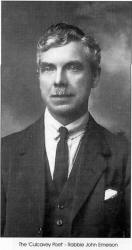 At the beginning of the twentieth century the Porter family lived at
number 2 Shop Row. All the members of this family were able to play
various musical instruments, such as the flute, the melodeon, the
accordion and drums. They were in fact a small local band, and played
for family occasions. One member of the Porter family made his mark in
the field of poetry, as detailed below. At the beginning of the twentieth century the Porter family lived at
number 2 Shop Row. All the members of this family were able to play
various musical instruments, such as the flute, the melodeon, the
accordion and drums. They were in fact a small local band, and played
for family occasions. One member of the Porter family made his mark in
the field of poetry, as detailed below.
Oliver Porter and Rabbie John Emerson were gifted
poets and this bonded them as great friends and they often exchanged
poems. Oliver emigrated to San Pedro, Los Angeles in USA as a young man.
He wrote many poems and published a book of some of them; they are all
inspirational and intellectual, great poems.
He returned to Culcavey in 1965, that is two years
after the death of Rabbie John. In Culcavey Stores he made himself known
to Bertie, Rabbie John's son, and had a chat about "old times". He said
that when he went to San Pedro, Los Angeles was 25 miles from his home,
now it was 25 miles past it and still sprawling. Oliver then went
outside and stood at the corner of Shop Row, looking across the Lagan
Valley towards the Antrim Hills. He was refreshing his memory, by
reliving his youth. In fact, some of his poetry did recall the `old
country'.
 |